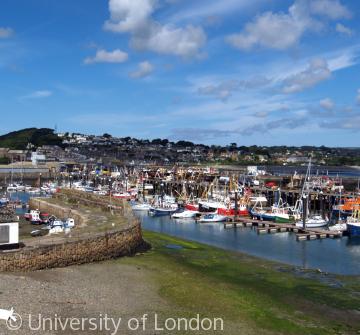Fishing
 Newlyn, across the bay from St Michael's Mount retained its fishing fleet when many Cornish fishing villages lost their primary industry
Newlyn, across the bay from St Michael's Mount retained its fishing fleet when many Cornish fishing villages lost their primary industryInland waters, fished for subsistence from prehistoric times, continued to provide a source of food throughout the medieval period and were managed for individual use and commercially. Glastonbury Abbey’s Fish House at Mere in Somerset, where the custodian of the mere lived, indicates how valuable fish were. River fishing too was usually controlled by landowners who let fishing rights, although jealously guarded rights to ‘free fishing’ were associated with some properties. River mouths were particularly productive but fishing methods could impede shipping and in turn be impeded by it as fish were caught commercially by obstructing watercourses with dams of stones or stakes or by nets fixed across the stream. The alternative was to fish from the sea shore or river bank using seine nets.
Early sea-fishing seems to have begun in many places as a seasonal activity organised from inland settlements and carried out by farmers. It could be done from the seashore or from natural harbours, where it was often developed as a trade and industry alongside other trading activities. Research on the pilchard fisheries of Cornwall shows that, by the 17th century, fishermen used hand-lines and drift nets in deep water and seine nets in the shallows, and traders in fish were recorded in fishing villages. Improvements to ports and fishing boats, especially the more widespread use from the 18th century of trawlers to catch bottom-feeding fish, encouraged the growth of highly organised deep-sea fishing. Whitby on the Yorkshire coast grew prosperous because of its whaling ventures round Greenland in the mid 18th century, as did other east coast ports, and in the mid 19th century Fleetwood in Lancashire expanded as its fishermen began to exploit the haddock grounds in the North Atlantic.
The fishing industry involved processing the fish so it could be carried long distances and stored for long periods. The main methods were salting and smoking. Fast transport to distant towns by rail stimulated the growth, from the mid-19th century, of many fishing ports such as Fleetwood, Grimsby and Lowestoft, and docks were developed by or in conjunction with railway companies. The technology for making ice, developed in the late 19th century, and later for freezing fish marked another step in processing, and since the 1970s major food companies have made towns like Grimsby into centres of frozen and cook-chill food production and the manufacture of associated machinery.
East coast ports were reliant mainly on herring fishing until the 1920s when stocks began to decline and their fishing fleets concentrated on trawling Icelandic waters for cod - 300,000 tons of it per year in the 1930s. Diminishing stocks and competition between Britain and Iceland led to the first ‘cod war’ in 1958, followed by others in 1972 and 1975. The European Union’s Common Fisheries Policy has set quotas which have had led to a decline in fishing and fishing ports and, in some places, reliance on industries which grew from the fishing industry or, in the picturesque fishing villages of the south-west, on tourism.
Special types of buildings give fishing villages and towns their distinctive character. The pilchard fishing in Mount’s Bay was associated with two-storeyed stone buildings with living accommodation about fish-processing cellars, while at Hastings tall timber net-drying sheds survive. Many of the larger ports, such as Hull and Grimsby, have lost most the buildings associated with their fishing hey-day, but some retain Victorian fish-processing works and fish markets, ice factories and shipping offices as well as port structures.





